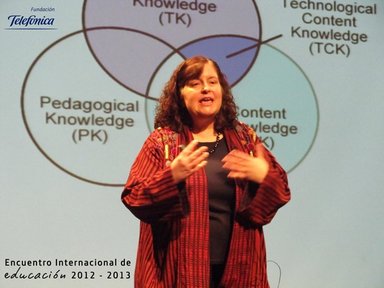|
Judi Harris is Professor Emerita and was the Pavey Family Chair in Educational Technology in the William & Mary School of Education in Williamsburg, Virginia, USA for 20 years: 2002 - 2022.
|
Dr. Harris’ research and service focus upon curriculum-based technology integration, instructional planning, and teacher professional development. During the past 43 years of her work in educational technology, she has authored Way of the Ferret: Finding and Using Educational Resources on the Internet (1994 & 1995, ISTE), one of the first books about K-12 educational use of the Internet; Virtual Architecture: Designing and Directing Curriculum-Based Telecomputing (1998, ISTE); Design Tools for the Internet-Supported Classroom (1998, ASCD); and more than 250 other research and pedagogical publications on curriculum-based applications of educational technologies. She also co-edited and co-authored the first edition of the Handbook of Technological Pedagogical Content Knowledge (TPACK) for Educators (Routledge, 2008), the first scholarly book to address the nature, development, and measurement of TPACK, the knowledge that teachers use to teach with educational technologies. The second edition of the TPACK Handbook was released in March 2016 by Routledge. The third edition is being written and edited in 2023-2024, to be released in 2025 by Routledge.
Judi’s work is used by teachers, technology specialists, and teacher educators internationally; especially her “activity structures” method for designing curriculum-based learning activities that incorporate use of online tools and resources. She and colleague Mark Hofer have adapted this notion to introduce curriculum-based “learning activity types” as instructional planning aids that help teachers integrate the full spectrum of digital and nondigital tools and resources into students’ learning experiences. Judi and Mark have worked with colleagues at eight other universities to develop activity type taxonomies for K-6 literacy, mathematics, music, physical education, science, secondary English, social studies, visual arts, and world languages curricula, and a teaching strategies taxonomy for teachers of English for Speakers of Other Languages (ESOL) students. All of these materials, plus TPACK measurement instruments created and tested by four of these colleagues, and interactive short courses that help teachers to learn to use the activity types in instructional planning, are available for use free of charge under a Creative Commons license at the Learning Activity Types website.
Prior to beginning work at William & Mary in 2002, Dr. Harris served on the faculty of the University of Nebraska-Omaha for two years, then the University of Texas at Austin for ten years, where she founded and directed WINGS Online (“Welcoming Interns and Novices with Guidance and Support Online”), a suite of online services that support new teachers in multiple ways. That work became the foundation of William & Mary’s ENDAPT (“Electronic Networking to Develop Accomplished Professional Teachers”), a second-generation suite of online services for new teachers. Her nonprofit Electronic Emissary telementoring service and research effort, begun in 1992 and retired in 2012, was the longest-running K-12 effort of its kind, and served students and teachers worldwide.
Judi’s work is used by teachers, technology specialists, and teacher educators internationally; especially her “activity structures” method for designing curriculum-based learning activities that incorporate use of online tools and resources. She and colleague Mark Hofer have adapted this notion to introduce curriculum-based “learning activity types” as instructional planning aids that help teachers integrate the full spectrum of digital and nondigital tools and resources into students’ learning experiences. Judi and Mark have worked with colleagues at eight other universities to develop activity type taxonomies for K-6 literacy, mathematics, music, physical education, science, secondary English, social studies, visual arts, and world languages curricula, and a teaching strategies taxonomy for teachers of English for Speakers of Other Languages (ESOL) students. All of these materials, plus TPACK measurement instruments created and tested by four of these colleagues, and interactive short courses that help teachers to learn to use the activity types in instructional planning, are available for use free of charge under a Creative Commons license at the Learning Activity Types website.
Prior to beginning work at William & Mary in 2002, Dr. Harris served on the faculty of the University of Nebraska-Omaha for two years, then the University of Texas at Austin for ten years, where she founded and directed WINGS Online (“Welcoming Interns and Novices with Guidance and Support Online”), a suite of online services that support new teachers in multiple ways. That work became the foundation of William & Mary’s ENDAPT (“Electronic Networking to Develop Accomplished Professional Teachers”), a second-generation suite of online services for new teachers. Her nonprofit Electronic Emissary telementoring service and research effort, begun in 1992 and retired in 2012, was the longest-running K-12 effort of its kind, and served students and teachers worldwide.
|
|
